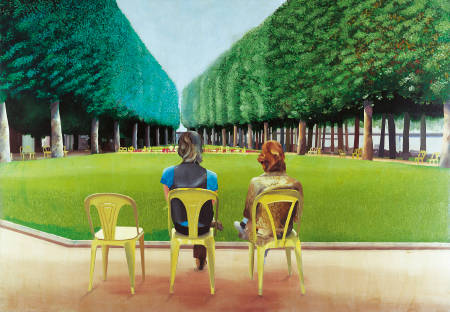
What to make of this recent article in The Atlantic, which finds that any critique of contemporary Letters is, by definition, an attack by an angry white male?
Joel Breuklander in The Atlantic takes eleven writers—Joanathan Franzen, David Foster Wallace, Verlyn Klinkenborg, J. Robert Lennon, Lee Siegel, Philip Roth, Ted Genoways, George Steiner, Frank Kermode, Alvin Kernan, and Mark Edmundson—and with a few quotes and great deal of innuendo, finds them all guilty of 1) literary criticism and 2) being straight, male and white.
Merely using random quotes out of context, the author of this brief Atlantic piece, titled “Literature Is Dead (According to Straight White Guys, At Least),” beats the old theme of eroding white male privilege, yet in none of his examples do any of the accused white male authors say literature is dead or dying because there’s not enough straight white males writing it.
In fact, not one shred of actual racist or sexist content is unearthed by The Atlantic. The charge of racism and sexism against white males is made simply because examples found of “Literature is dead or dying” critiques are written by white males. So The Atlantic is either racist or stupid. We’re going to be nice, and say stupid. Here’s what a stupid person “wracking their brain” sounds like:
Surely there are a decent number of straight white men in the world of literature who aren’t doom-and-gloom pessimists about its future. But despite wracking my brain and looking through online media and academic archives, I could find no female or non-white writers who have made comparable statements, none who have similarly contributed to this literary despair.
The Atlantic’s ire is focused on the author of the recent controversial Harper’s essay, Mark Edmundson, the villain who is guilty of wanting the poet to speak for everyone. Joel Breuklander is so irate at this notion that he loses all perspective and claims that Edmundson’s wish is somehow “factually untrue:”
Edmundson’s point is factually untrue. Poets of all kinds still use ‘we’ and ‘our’ and ‘us.’ But if they do so from the perspective of a gay man, a woman, a black woman, a Hispanic man, their attempts to look at big themes are often overlooked or dismissed rather than championed.
The Atlantic says the desire for the poet to speak to all races is racist. The poet, according to The Atlantic, can only use “we” when speaking to their group.
We have now arrived at the Great anti-Racist Racist Ideal: Universality is racist.
Feeling confused? Feeling like no matter what you say, you are racist? Welcome to the club.
Joel Breuklander trots out the example of Richard Blanco’s Inauguration Poem and then points an accusing finger at Edmundson:
Does Blanco, who is gay and Latino, even count for Edmundson?
Yes, Mr. Breuklander, obviously, Richard Blanco, the poet, doesn’t count for Mr. Edmundson, because he is gay and Latino. There is no escape for Mr. Edmundson. He is obviously guilty!
And horrors! Edmundson “ignores the entirety” of a poet’s work—and that poet is a woman! Whenever someone makes a negative comment about a poet we like, we can always satisfy ourselves by saying the malicious critic is “ignoring” the “entirety of the work” which looms over whatever the point happens to be. In this case the point is “sex as a major subject of poetry,” and Breuklander “proves” his point by selecting from the “entirety” of Carson’s work one quote–-which dismisses sex as a subject! “Sex is a substitute…”
Edmundson dismisses Anne Carson, too, as “opaque” and “inscrutable”—the same Anne Carson who became a hit when her compulsively readable, gay coming-of-age “novel in verse” Autobiography of Red was name-dropped on Sex and the City. When Edmundson asserts that “no well-known poet” writes about big subjects like sex, he ignores the entirety of Carson’s work. Take just one example from her collection Plainwater: “Men know almost nothing about desire / they think it has to do with sexual activity / or can be discharged that way. / But sex is a substitute, like money or language.”
As a woman, though, does Carson count? Do her broad statements on gender and sex not matter for Edmundson’s thesis?
Maybe it’s just that Edmunson doesn’t like the hyped-up Carson’s poetry. Should this be a source of outrage?
For Breuklander, accusing someone of racism without evidence is fine, but not being wowed by someone’s poetry is a crime against humanity.
Breuklander hasn’t considered that literature’s “decline” hurts everyone, not just white people.
Literature would hardly seem in decline to the women or ethnic or sexual minorities just now getting access to its hallowed halls. That’s why Edmundson’s silliest assertion is that nobody finds themselves represented by poetry anymore. “No one,” he writes, “will say what Emerson hoped to say when he encountered a poet who mattered: ‘This is my music, this is myself.’”
But if Edmundson only recognizes himself in older, white, male poets, it may just be because he’s older, white, and male.
We quote The Atlantic a final time—note the illogical leap here: somehow it is racist to accuse contemporary literature of “technical narrowness,” being “boring,” or being “professionalized.”
I’ve suspected for a while that these essays, as a category, might somehow be rooted in declining privilege: Literature has never been a majority interest in America, so I’ve wondered if these writers might be projecting some kind of status insecurity onto literature. Still, until recently I’d never thought to look at the identities of the authors before. And I certainly never thought I’d discover that every last author whose work I had read on the subject would be a white male—or that all but one was straight.
Take The New York Times’ Verlyn Klinkenborg, who recently wrote that a “technical narrowness” is responsible for the “decline and fall of the English major.” A few months prior, J. Robert Lennon derided contemporary literary fiction as “fucking boring” in Salon. Before that, Lee Siegel informed us that today’s fiction is “irrelevant” because it is too professionalized, and because nonfiction got quite good.
We don’t know if Seth Abramson is safe, or not. In a very recent piece in the Huff Post, he dismisses Edmundson’s “jeremiad” as “poorly researched.”
“Poorly researched” in this case means that Edmundson did not read the “entirety” of every poet’s work now writing in the United States.
But then Abramson—a white person!!—risks a “Literature is Dead or Dying” critique of contemporary literature:
American literary study and discourse has, regrettably, devolved since Epstein’s and Goia’s direct assaults on the state of poetry a quarter of a century ago. According to a recent article in The New York Times, in 1991 Yale University graduated 165 English majors; it graduated 62 in 2013…
What? No mention that Joseph Epstein (Who Killed Poetry?) and Dana Gioia (Can Poetry Matter?) are white?
But wait, perhaps Abramson is safe, because he claims that literature is not really dying at all:
Yet the recent history of literary study in the U.S. isn’t nearly as grim if we consider the evolution of creative writing, an English department specialization that from 1971 to 2003 grew by 908 percent—that’s not a typo—if we measure the discipline by how many terminal-degree graduate programs are devoted to its study. The effect of this unprecedented growth is that in 2013 there are aproximately 250 terminal-degree graduate creative writing programs in the United States. In 1991, when Gioia wrote of his concern about the future of American poetry, there were but fifty such programs (and half of these had, at that point, graduated five or fewer classes of poets).
Welcome to the Program Era, where literature is dead, but everybody is writing it.
And now Abramson rises to the occasion, quoting the aged poet John Ashbery:
As the nation’s most critically acclaimed poet, John Ashbery, once detailed in an interview with The Paris Review, what first awakened him to the joys of poetry was seeing that “poetry wasn’t just something lifeless in an ancient museum, but must have grown out of the lives of the people who wrote it.” Ashbery, still a working poet today, is exactly right: If we want the nation’s youngest readers to take up an interest in poetry, we must introduce them to more working poets and fewer academics, and indeed make exposure to working poets in real-time mandatory precursor to the reading of contemporary American poetry.
So here is Abramson, who evidently thinks there is something magical about the phrase “working poet,” selecting for a rare specimen of wisdom an utterance from “the nation’s most critically acclaimed poet” and what is this wisdom?
If something that someone has written is in a museum, an “ancient” museum, (!) it is “lifeless” and has not “grown out of the lives of the people who wrote it.”
This is absolute rubbish. Can it be “the nation’s most critically acclaimed poet” in the U.S. actually believes this piece of stupidity?
Surely poetry is not afflicted with the racism The Atlantic has “discovered”—and stupidity like this from John Ashbery as well?



































